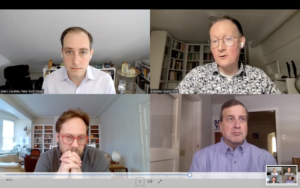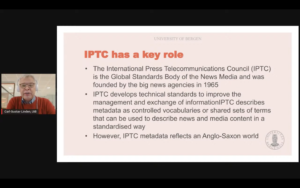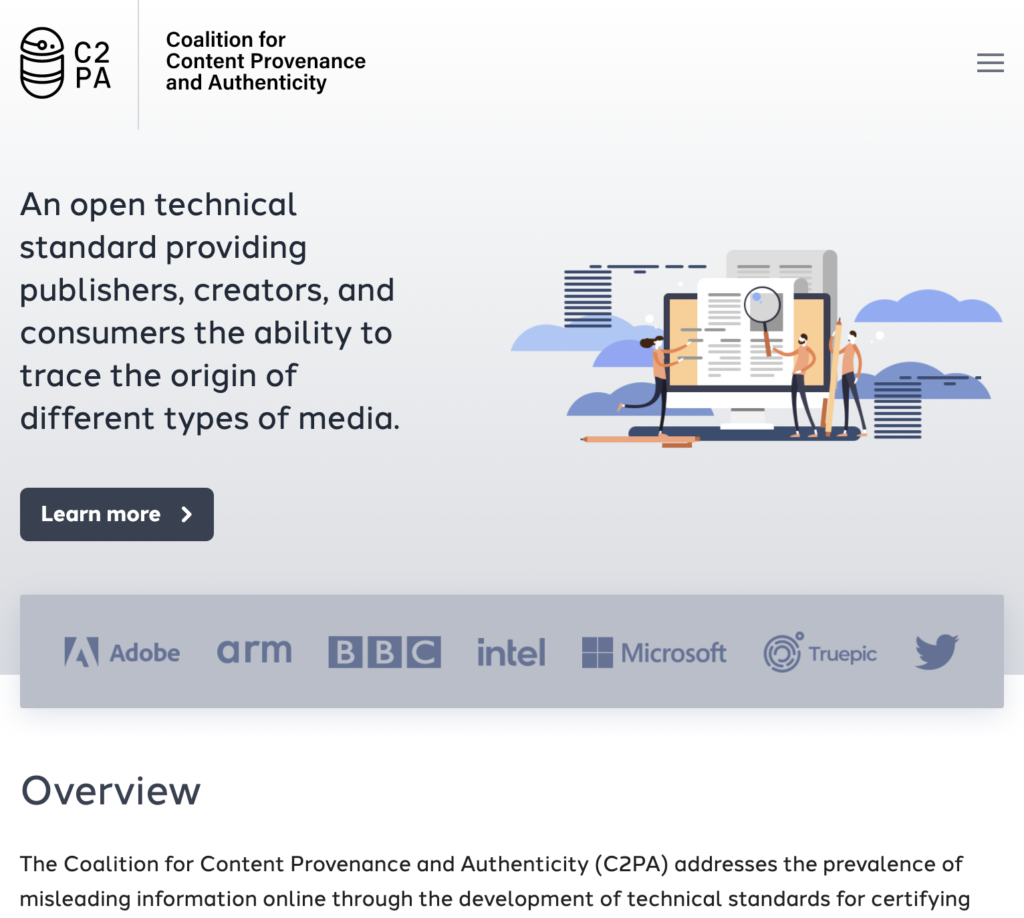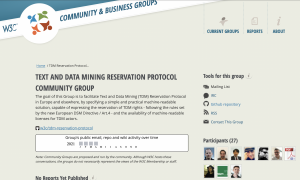Categories
Archives
IPTC members will be appearing at imaging.org’s Imaging Science and Technology DigiTIPS 2022 meeting series tomorrow, April 26.
The session description is as follows:
Unmuting Your ‘Silent Images’ with Photo Metadata
Caroline Desrosiers, founder and CEO, Scribely
David Riecks and Michael Steidl, IPTC Photo Metadata Working GroupAbstract: Learn how embedded photo metadata can aid in a data-driven workflow from capture to publish. Discover what details exist in your images; and learn how you can affix additional information so that you and others can manage your collection of images. See how you can embed info to automatically fill in “Alt Text” to images shown on your website. Explore how you can test your metadata workflow to maximize interoperability.”
Registration is still open. You can register at https://www.imaging.org/Site/IST/Conferences/DigiTIPS/DigiTIPS_Home.aspx?Entry_CCO=3#Entry_CCO

A hot topic in media circles these days is “synthetic media”. That is, media that was created either partly or fully by a computer. Usually the term is used to describe content created either partly or wholly by AI algorithms.
IPTC’s Video Metadata Working Group has been looking at the topic recently and we concluded that it would be useful to have a way to describe exactly what type of content a particular media item is. Is it a raw, unmodified photograph, video or audio recording? Is it a collage of existing photos, or a mix of synthetic and captured content? Was it created using software trained on a set of sample images or videos, or is it purely created by an algorithm?
We have an existing vocabulary that suits some of this need: Digital Source Type. This vocabulary was originally created to be able to describe the way in which an image was scanned into a computer, but it also represented software-created images at a high level. So we set about expanding and modifying that vocabulary to cover more detail and more specific use cases.
It is important to note that we are only describing the way a media object has been created: we are not making any statements about the intent of the user (or the machine) in creating the content. So we deliberately don’t have a term “deepfake”, but we do have “trainedAlgorithmicMedia” which would be the term used to describe a piece of content that was created by an AI algorithm such as a Generative Adversarial Network (GAN).
Here are the terms we propose to include in the new version of the Digital Source Type vocabulary. (New terms and definition changes are marked in bold text. Existing terms are included in the list for clarity.)
| Term ID | digitalCapture |
| Term name | Original digital capture sampled from real life |
| Term description | The digital media is captured from a real-life source using a digital camera or digital recording device |
| Examples | Digital photo or video taken using a digital SLR or smartphone camera |
| Term ID | negativeFilm |
| Term name | Digitised from a negative on film |
| Term description | The digital media was digitised from a negative on film on any other transparent medium |
| Examples | Film scanned from a moving image negative |
| Term ID | positiveFilm |
| Term name | Digitised from a positive on film |
| Term description | The digital media was digitised from a positive on a transparency or any other transparent medium |
| Examples | Digital photo scanned from a photographic positive |
| Term ID | |
| Term name | Digitised from a print on non-transparent medium |
| Term description | The digital image was digitised from an image printed on a non-transparent medium |
| Examples | Digital photo scanned from a photographic print |
| Term ID | humanEdited |
| Term name | Original media with minor human edits |
| Term description | Minor augmentation or correction by a human, such as a digitally-retouched photo used in a magazine |
| Examples | Video camera recording, manipulated digitally by a human editor |
| Term ID | compositeCapture |
| Term name | Composite of captured elements |
| Term description | Mix or composite of several elements that are all captures of real life |
| Examples | * A composite image created by a digital artist in Photoshop based on several source images * Edited sequence or composite of video shots |
| Term ID | algorithmicallyEnhanced |
| Term name | Algorithmically-enhanced media |
| Term description | Minor augmentation or correction by algorithm |
| Examples | A photo that has been digitally enhanced using a mechanism such as Google Photos’ “de-noise” feature |
| Term ID | dataDrivenMedia |
| Term name | Data-driven media |
| Term description | Digital media representation of data via human programming or creativity |
| Examples | A representation of a distant galaxy created by analysing the outputs of a deep-space telescope (as opposed to a regular camera) An infographic created using a computer drawing tool such as Adobe Illustrator or AutoCAD |
| Term ID | digitalArt |
| Term name | Digital art |
| Term description | Media created by a human using digital tools |
| Examples | * A cartoon drawn by an artist into a digital tool using a digital pencil, a tablet and a drawing package such as Procreate or Affinity Designer * A scene from a film/movie created using Computer Graphic Imagery (CGI) * Electronic music composition using purely synthesised sounds |
| Term ID | virtualRecording |
| Term name | Virtual recording |
| Term description | Live recording of virtual event based on synthetic and optionally captured elements |
| Examples | * A recording of a computer-generated sequence, e.g. from a video game * A recording of a Zoom meeting |
| Term ID | compositeSynthetic |
| Term name | Composite including synthetic elements |
| Term description | Mix or composite of several elements, at least one of which is synthetic |
| Examples | * Movie production using a combination of live-action and CGI content, e.g. using Unreal engine to generate backgrounds * A capture of an augmented reality interaction with computer imagery superimposed on a camera video, e.g. someone playing Pokemon Go |
| Term ID | trainedAlgorithmicMedia |
| Term name | Trained algorithmic media |
| Term description | Digital media created algorithmically using a model derived from sampled content |
| Examples | * Image based on deep learning from a series of reference examples * A “speech-to-speech” generated audio or “deepfake” video using a combination of a real actor and an AI model * “Text-to-image” using a text input to feed an algorithm that creates a synthetic image |
| Term ID | algorithmicMedia |
| Term name | Algorithmic media |
| Term description | Media created purely by an algorithm not based on any sampled training data, e.g. an image created by software using a mathematical formula |
| Examples | * A purely computer-generated image such as a pattern of pixels generated mathematically e.g. a Mandelbrot set or fractal diagram * A purely computer-generated moving image such as a pattern of pixels generated mathematically |
We propose that the following term, which exists in the current DigitalSourceType CV, be retired:
| Term ID | RETIRE: softwareImage |
| Term name | Created by software |
| Term description | The digital image was created by computer software |
| Note | We propose that trainedAlgorithmicMedia or algorithmnicMedia be used instead of this term. |
We welcome all feedback from across the industry to these proposed terms.
Please contact Brendan Quinn, IPTC Managing Director at mdirector@iptc.org use the IPTC Contact Us form to send your feedback.

The IPTC has an ongoing project to the news and media industry deal with content credibility and provenance. As part of this, we have started working with Project Origin, a consortium of news and technology organisations who have come together to fight misinformation through the use of content provenance technologies.
On Tuesday 22nd February, Managing Director of IPTC Brendan Quinn spoke on a panel at an invite-only Executive Briefing event attended by leaders from news organisations around the world.
Other speakers at the event included Marc Lavallee, Head of R&D for The New York Times, Pascale Doucet of France Télévision, Eric Horvitz of Microsoft Research, Andy Parsons of Adobe, and Laura Ellis, Jamie Angus and Jatin Aythora of the BBC.
The event marks the beginning of the next phase of the industry’s work on content credibility. C2PA has now delivered the 1.0 version of its spec, so the next phase of the work is for the news industry to get together to create best practices around implementing it in news workflows.
IPTC and Project Origin will be working together with stakeholders from all parts of the news industry to establish guidelines for making provenance work in a practical way across the entire news ecosystem.

Bill Kasdorf, IPTC Individual Member, has written about IPTC Photo Metadata in his latest column for Publishers Weekly.
In the article, a double-page spread in the printed version of the 11/22/2021 issue of Publishers Weekly and an extended article online, Bill references Caroline Desrosiers of IPTC Startup member Scribely saying “if publications are born accessible, then their images should be born accessible, as well.”
The article describes how the new Alt Text (Accessibility) and Extended Description (Accessibility) properties in IPTC Photo Metadata can be used to make EPUBs more accessible.
Bill goes on to provide an example, supplied by Caroline Desrosiers, of how an image’s caption, alt text and extended description fulfil very different purposes, and mentions that it’s perfectly fine to leave alt text blank in some cases! For more details, read the article here.

“Metadata is the wheel in the digital business model,” according to Carl-Gustav Linden of University of Bergen in Norway. “We can use it to combine the right content with the right readers, listeners and viewers. That’s why metadata is so essential.”
Professor Linden was speaking at the JournalismAI Festival taking place this week, hosted by the Polis think-tank at the London School of Economics and Political Science. The JournalismAI project is a collaboration between POLIS and newsrooms and institutes around the world, funded by the Google News Initiative.
We are very happy to see several mentions of IPTC standards and IPTC members, particularly the New York Times and iMatrics. The New York Times is seen as a forerunner in content classification, with Jennifer Parrucci (lead of the IPTC NewsCodes Working Group) giving presentations recently about their work. iMatrics supplies an automated content classification system based on IPTC Media Topics which can be used as part of editorial workflows.
One thing we would like to note is that Professor Linden mentions that the IPTC vocabularies are influenced by our background in US-based news organisations, citing an example of the schools terms being focussed on the US system. We are happy to say that in a recent update to IPTC Media Topics we clarified our terms around school systems, making the label names and descriptions much more generic and based on the international schools classifications.
This change was the result of many IPTC member organisations working together from different parts of the world, including Scandinavia, to come to a result that hopefully works for everyone (and of course, each user of Media Topics is welcome to extend the vocabulary for their own purposes if necessary). This is an example of the great work that takes place when our members work together.
The JournalismAI festival continues until Friday this week. All sessions from the festival are available on YouTube.
Thanks again to Polis and the JournalismAI team for giving us a mention!
As previously announced, the IPTC are participating in the Coalition for Content Provenance and Authenticity (C2PA) project to create a specification to tackle online disinformation and misinformation.

After months of work by the C2PA Technical Working Group, the first public draft of the specification has been released. In particular, the spec defines how properties from the IPTC Photo Metadata Standard can be included in a C2PA manifest, creating a provenance trail that allows future viewers to validate the authenticity of a claim associated with a media asset (such as the location the photo was taken, the creator’s name or who is the person in a photo).
The full press release from C2PA follows:
SAN FRANCISCO, Calif. — September 1, 2021 — Today, the Coalition for Content Provenance and Authenticity (C2PA), a Joint Development Foundation project established to scale trust in online content, released its content provenance specifications – in draft form – for community review and feedback. Driven by a commitment to tackle online disinformation, the C2PA’s technical specifications are designed to be an open standard that will allow publishers, creators and consumers to trace the origin and evolution of a piece of media, including images, videos, audio and documents.
“C2PA was established to accelerate progress toward the broad adoption of content provenance standards that will enable a future of verifiable integrity in media,” said Andrew Jenks, C2PA Chair. “The release of this draft is an exciting and important milestone, representing a diverse and collaborative effort across industries to protect people from fabricated and manipulated media and drive transparency in the origin and history of content.”
Combatting online content fraud at scale requires transparency and an accessible and open approach that enables consumers to make informed decisions about what has been modified and what has not. The C2PA was launched in February 2021 with founding members Adobe, Arm, BBC, Intel, Microsoft and Truepic with the goal of developing an end-to-end open technical standard to address the rise of disinformation efforts leveraging tools for media fabrication and manipulations. The effort has expanded, bringing in additional members including Twitter, WITNESS, Akamai and Fastly.
Over the past six months, the C2PA has worked with industry experts and partner organizations, including the Project Origin Alliance and the Content Authenticity Initiative (CAI), to develop a standard for digital provenance that provides platforms with a method to define descriptive metadata, what information is associated with each type of asset, how that information is presented and stored, and how evidence of tampering can be identified. This group of contributors spans a spectrum of industries including social media, news publishing, software technology, semiconductors and more. All have contributed to building these new technical specifications through a process of gathering requirements, considerations of scenarios and technical design.
Following the review period, the C2PA working groups will finalize the 1.0 version of the technical standards and once published, the group will pursue adoption, prototyping and communication through coalition members and other external stakeholders, providing the foundation for a system of verifiable provenance on the internet.
“The power of C2PA’s open standard will rely on its broad adoption by producers and custodians of content, which makes this review phase so critical to the development and finalization of the specifications,” said Jenks. “This is why we are making the draft specification available to the public. We encourage rigorous review and feedback across industries, civil society, academia, and the general public to ensure the C2PA standards reflect the complex nature of this effort.”
The draft specification can be accessed through the C2PA website, and comments will be accepted through a web submission form and GitHub until November 30, 2021.
C2PA is accepting new members. To join, visit https://c2pa.org/membership/.
About C2PA
The Coalition for Content Provenance and Authenticity (C2PA) is an open, technical standards body addressing the prevalence of misleading information online through the development of technical standards for certifying the source and history (or provenance) of media content. C2PA is a Joint Development Foundation project, formed through an alliance between Adobe, Arm, BBC, Intel, Microsoft and Truepic. For more information, visit c2pa.org.
Last week, Brendan Quinn and Jennifer Parrucci presented about IPTC NewsCodes at the EBU’s Metadata Developer Network workshop.
Brendan Quinn of IPTC and Jennifer Parrucci of The New York Times present IPTC’s NewsCodes vocabularies, describing what they are, how they are maintained, how they can be used and a look into the future. Including a focus on IPTC MediaTopics, our leading vocabulary for topics of news content. Originally presented at the EBU Metadata Developers Network workshop, held online from 25 – 27 May 2021.
The full presentation slides are embedded below. A video recording of the session, including questions and answers, is available to EBU members via the EBU MDN website.
 Brendan Quinn, Managing Director of IPTC, spoke on 20 April 2021 at the regular meeting of the W3C Text and Data Mining Reservation Protocol Community Group.
Brendan Quinn, Managing Director of IPTC, spoke on 20 April 2021 at the regular meeting of the W3C Text and Data Mining Reservation Protocol Community Group.
The Community Group, open to anyone to join, is discussing how to “facilitate a technical protocol to reserve a publisher’s right for content to be made available for text and data mining (TDM). The solution should be capable of expressing the reservation of TDM rights – following the rules set by Article 4 of the new European DSM Directive – and the availability of machine-readable licenses for TDM actors.”
The Community Group is looking at various technologies for representing machine-readable licences, and Brendan presented IPTC’s RightsML as a possible option. Based on W3C’s ODRL, RightsML allows rights holders to specify permissions, prohibitions and constraints on usage of all types of media content, so it may be a good candidate for representing rights around data mining.
Laurent Le Meur, Chair of the TDM Reservation Protocol Community Group and previous contributor to IPTC, presented at the IPTC Autumn Meeting in 2020 to discuss the proposed project.
schema.org is the technology used by web site owners around the world to make metadata available to search engines and other third-party services. It is widely used to embed machine-readable data in websites for products, store opening times and much more.
It is also used as one of the sources of metadata for the Google search results. The schema.org “license”, “acquireLicensePage” and “creator” properties in a page’s HTML code are used in addition to IPTC Photo Metadata embedded in image files to populate the image panel.
schema.org version 11 was released this week. It contains two new properties on the CreativeWork type (and therefore its subtypes such as ImageObject) that were created to match their equivalent properties in IPTC Photo Metadata: copyrightNotice, which matches the IPTC Photo Metadata Copyright Notice property, and creditText, which matches the IPTC Photo Metadata Credit Line property.
The new fields are not yet supported by Google images search, but hopefully will be soon.
After the recent update, the current properties mapped to schema.org and used in Google images search results are:
| IPTC Photo Metadata property | Matching schema.org property | Used in Google search results? |
| Creator | ImageObject -> creator | Yes |
| Copyright Notice | ImageObject -> copyrightNotice | Not yet |
| Credit Line | ImageObject -> creditText | Not yet |
| Web Statement of Rights | ImageObject -> license | Yes |
| Licensor / Licensor URL | ImageObject -> acquireLicensePage | Yes |
The IPTC Photo Metadata Working Group is working on a more comprehensive document showing all possible IPTC Photo Metadata fields with their schema.org and EXIF equivalents. The full mapping document will be released soon.
Yesterday Michael Steidl, Lead of the IPTC Photo Metadata Working Group, gave a webinar to Bundesverband professioneller Bildanbieter (BVPA), the Federal Association of Professional Image Providers in Germany.

The webinar focused on the recently introduced image license information for Google image searches and the possible opportunities and risks for the professional image business.
“This year, Google introduced the so-called Licensable Badge for its image search. This feature enables images to be linked to license information and to be displayed in the image search results with a corresponding link. Image seekers from advertising, editorial offices and corporate PR can follow the link to obtain further information on how to use the image. This turns Google image search into a potential marketplace. But how can image providers use the new tool for themselves? Is it worth the effort of storing the necessary metadata? Are there any economic risks involved? Will Google soon become a meta picture agency?”
In the first part of the webinar, Michael Steidl explained which image metadata must be stored in order to display photo credits and “licensable” badges on Google. He also informed participants about the problem that certain software and web platforms deletes image metadata after upload.
In the second part, Alexander Karst explains the possibilities for increasing visibility through the new features and gives an assessment of the effects on the image market.
Thanks to BVPA for hosting Michael for the webinar.